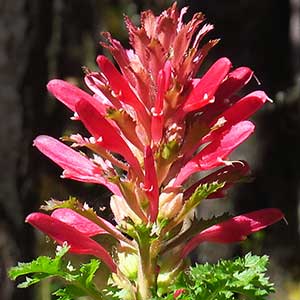Pedicularis densiflora
Pedicularis sudetica
Indian warrior, warrior's plume
fernweed, Oeder's lousewort, sudetan lousewort, sudeten lousewort, sudetic lousewort
basal 1–10, blade lanceolate, 30–200 x 20–70 mm, 2(or 3)-pinnatifid, margins of adjacent lobes nonoverlapping or extensively overlapping distally, 1-serrate, surfaces glabrous, hispid, or downy;
cauline 4–20, blade lanceolate, 15–250 x 5–100 mm, 2-pinnatifid, margins of adjacent lobes nonoverlapping or extensively overlapping distally, serrate, surfaces glabrous, hispid, or downy.
basal 1–20, blade elliptic to lanceolate, 10–110 x 3–26 mm, 1- or 2-pinnatifid, margins of adjacent lobes nonoverlapping or slightly overlapping distally, serrate, surfaces glabrous;
cauline 0–5, blade lanceolate to elliptic, 20–90 x 2–20 mm, 1- or 2-pinnatifid, margins of adjacent lobes nonoverlapping or slightly overlapping distally, 1- or 2-serrate, surfaces glabrous, some hairs along veins on abaxial surface.
simple, 1–5, exceeding basal leaves, each 10–50-flowered;
bracts lanceolate to trullate, 10–35 x 3–5 mm, undivided or 1-pinnatifid, proximal margins entire, distal 1- or 2-serrate, surfaces glabrous.
simple, 1–4, exceeding basal leaves, each 10–50-flowered;
bracts linear to subulate or trullate, 2–15 x 1–4 mm, undivided with or without long auricles, or 1-pinnatifid, margins entire, serrate, or serrulate, surfaces glabrous, white- or yellowish white-lanate, or sparsely pilose.
2–4 mm.
1–2.5 mm.
calyx 9–18 mm, downy to tomentose, lobes 5, triangular, 3–4 mm, apex entire, ciliate;
corolla 23–43 mm, tube dark red, purple, or orange-yellow, rarely white, 8–18 mm;
galea dark red, purple, or orange-yellow, rarely white, 15–25 mm, beakless, margins entire medially and distally, apex straight;
abaxial lip dark red, purple, or orange-yellow, rarely white, 8–15 mm.
calyx 7–13 mm, glabrous, white-lanate, yellowish white-lanate, or sparsely pilose, lobes 5, subulate or triangular, 1.5–5 mm, apex entire, crenulate, or serrulate, glabrous, sometimes ciliate;
corolla 16–21 mm, tube pink, purple, or magenta, 9–11 mm;
galea purple, magenta, or bicolored, 7–12 mm, beakless, margins entire medially, 1-toothed or entire distally, apex arching over abaxial lip;
abaxial lip white or pink with purple spots, purple, or magenta, 4–8 mm.
= 16.
Pedicularis densiflora
Pedicularis sudetica
Scarlet corollas with an undomed, toothless galea and two- or three-pinnatifid leaves are diagnostic of Pedicularis densiflora. This species occurs in forested subalpine regions of southern Oregon, western slopes of the Sierra Nevada, and the Coast Ranges of California south to Baja California. Herbarium records indicate northern populations of P. densiflora occur at higher elevations than do more southern populations.
(Discussion copyrighted by Flora of North America; reprinted with permission.)
Subspecies 6 (5 in the flora).
Pedicularis sudetica is a difficult complex. Hultén employed the degree of lobing on subtending floral bracts, length of corolla tubes, and inflorescence vestiture in recognizing eight infraspecific taxa. U. Molau and D. F. Murray (1996) emphasized presence or absence of spots on the abaxial lip, inflorescence vestiture, length of petioles and calyx, and ecological features to define four species, subsuming several of Hultén’s other subspecific taxa into these species. According to Molau and Murray, P. sudetica in the narrow sense is a morphologically distinct, disjunct taxon endemic to the Sudeten Mountains of central Europe, but part of the broader circumscription by Hultén (1961, 1964), which is treated here as the sixth subspecies.
U. Molau and D. F. Murray (1996) did not include subsp. scopulorum in their analysis, noting only that teeth are virtually absent on the galea of Pedicularis scopulorum. Presence or absence of apical teeth on the margins of the galea often distinguishes species in other Pedicularis taxa. Because teeth are sometimes present in this taxon, it is treated here as one of the five North American subspecies in the broad sense of P. sudetica. A recent molecular study confirms its close relationship to other members of the complex (B. W. Robart et al. 2015).
When comparing the two alternative taxonomies, the treatment by U. Molau and D. F. Murray (1996) is easier to apply. Close inspection of specimens identified as these species often reveals combinations of traits attributable to more than one taxon; Molau and Murray reported finding hybridization common between Pedicularis albolabiata and P. arctoeuropaea, and P. albolabiata and P. pacifica where habitats overlap, indicating that reproductive isolation is not complete. Recognition of these taxa as varieties may be more appropriate considering the broad geographic overlap where the few distinguishing features tend to intergrade. They are treated here, however, as subspecies. The following key is modified from Molau and Murray.
(Discussion copyrighted by Flora of North America; reprinted with permission.)
1. Calyx lobe margins entire distally. | → 2 |
2. Calyx lobes subulate; Alberta, British Columbia, Manitoba, Northwest Territories, Nunavut, Ontario, Yukon, Alaska. | subsp. interior |
2. Calyx lobes triangular; Colorado, New Mexico, Wyoming. | subsp. scopulorum |
1. Calyx lobe margins crenulate or serrulate distally. | → 3 |
3. Corollas: abaxial lips purple-spotted. | → 4 |
4. Corollas: galeas bicolored; abaxial lips white, rarely pink; calyces and bracts glabrous or white-lanate. | subsp. albolabiata |
4. Corollas: galeas not bicolored; abaxial lips magenta; calyces and bracts yellowish white-lanate, rarely glabrous. | subsp. arctoeuropaea |
3. Corollas: abaxial lips not purple-spotted. | → 5 |
5. Calyces and bracts white-lanate, calyx lobe margins entire or serrulate distally. | subsp. interior |
5. Calyces and bracts glabrous or sparsely pilose, calyx lobe margins serrulate distally. | subsp. pacifica |


